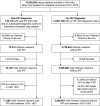Agent Orange Exposure and Risk of Idiopathic Pulmonary Fibrosis among U.S. Veterans
- PMID: 35559726
- PMCID: PMC9799114
- DOI: 10.1164/rccm.202112-2724OC
Agent Orange Exposure and Risk of Idiopathic Pulmonary Fibrosis among U.S. Veterans
Abstract
Rationale: There is limited literature exploring the relationship between military exposures and idiopathic pulmonary fibrosis (IPF). Objectives: To evaluate whether exposure to Agent Orange is associated with an increased risk of IPF among veterans. Methods: We used Veterans Health Administration data to identify patients diagnosed with IPF between 2010 and 2019. We restricted the cohort to male Vietnam veterans and performed multivariate logistic regression to examine the association between presumptive Agent Orange exposure and IPF. We conducted sensitivity analyses restricting the cohort to army veterans (highest theoretical burden of exposure, surrogate for dose response) and a more specific case definition of IPF. Fine-Gray competing risk models were used to evaluate age to IPF diagnosis. Measurements and Main Results: Among 3.6 million male Vietnam veterans, 948,103 (26%) had presumptive Agent Orange exposure. IPF occurred in 2.2% of veterans with Agent Orange exposure versus 1.9% without exposure (odds ratio, 1.14; 95% confidence interval [CI], 1.12-1.16; P < 0.001). The relationship persisted after adjusting for known IPF risk factors (odds ratio, 1.08; 95% CI, 1.06-1.10; P < 0.001). The attributable risk among exposed veterans was 7% (95% CI, 5.3-8.7%; P < 0.001). Numerically greater risk was observed when restricting the cohort to 1) Vietnam veterans who served in the army and 2) a more specific definition of IPF. After accounting for the competing risk of death, veterans with Agent Orange exposure were still more likely to develop IPF. Conclusions: Presumptive Agent Orange exposure is associated with greater risk of IPF. Future research should validate this association and investigate the biological mechanisms involved.
Keywords: Veterans health; epidemiology; interstitial lung disease.
Figures


Comment in
-
The Long-Term Respiratory Perils of War.Am J Respir Crit Care Med. 2022 Sep 15;206(6):662-663. doi: 10.1164/rccm.202206-1064ED. Am J Respir Crit Care Med. 2022. PMID: 35675559 Free PMC article. No abstract available.
Similar articles
-
Risk of testicular cancer associated with surrogate measures of Agent Orange exposure among Vietnam veterans on the Agent Orange Registry.Ann Epidemiol. 1994 Jan;4(1):11-6. doi: 10.1016/1047-2797(94)90037-x. Ann Epidemiol. 1994. PMID: 8205269
-
Exposure to Agent Orange is associated with increased recurrence after surgical treatment of stage I non-small cell lung cancer.J Thorac Cardiovasc Surg. 2024 May;167(5):1591-1600.e2. doi: 10.1016/j.jtcvs.2023.09.013. Epub 2023 Sep 12. J Thorac Cardiovasc Surg. 2024. PMID: 37709166
-
Agent Orange exposure, Vietnam War veterans, and the risk of prostate cancer.Cancer. 2008 Nov 1;113(9):2464-70. doi: 10.1002/cncr.23695. Cancer. 2008. PMID: 18666213
-
A critical review of the epidemiology of Agent Orange/TCDD and prostate cancer.Eur J Epidemiol. 2014 Oct;29(10):667-723. doi: 10.1007/s10654-014-9931-2. Epub 2014 Jul 27. Eur J Epidemiol. 2014. PMID: 25064616 Free PMC article. Review.
-
Environmental fate and bioavailability of Agent Orange and its associated dioxin during the Vietnam War.Environ Sci Pollut Res Int. 2004;11(6):359-70. doi: 10.1007/BF02979652. Environ Sci Pollut Res Int. 2004. PMID: 15603524 Review.
Cited by
-
The Long-Term Respiratory Perils of War.Am J Respir Crit Care Med. 2022 Sep 15;206(6):662-663. doi: 10.1164/rccm.202206-1064ED. Am J Respir Crit Care Med. 2022. PMID: 35675559 Free PMC article. No abstract available.
-
Microorganism-Driven 2,4-D Biodegradation: Current Status and Emerging Opportunities.Molecules. 2024 Aug 15;29(16):3869. doi: 10.3390/molecules29163869. Molecules. 2024. PMID: 39202952 Free PMC article. Review.
-
Environmental Causes of Idiopathic Pulmonary Fibrosis.Int J Mol Sci. 2023 Nov 18;24(22):16481. doi: 10.3390/ijms242216481. Int J Mol Sci. 2023. PMID: 38003670 Free PMC article. Review.
-
Mechanisms on How Matricellular Microenvironments Sustain Idiopathic Pulmonary Fibrosis.Int J Mol Sci. 2025 Jun 4;26(11):5393. doi: 10.3390/ijms26115393. Int J Mol Sci. 2025. PMID: 40508199 Free PMC article. Review.
-
Disparities in Antifibrotic Medication Utilization Among Veterans With Idiopathic Pulmonary Fibrosis.Chest. 2023 Aug;164(2):441-449. doi: 10.1016/j.chest.2023.02.027. Epub 2023 Feb 18. Chest. 2023. PMID: 36801465 Free PMC article.
References
-
- Raghu G, Remy-Jardin M, Myers JL, Richeldi L, Ryerson CJ, Lederer DJ, et al. American Thoracic Society, European Respiratory Society, Japanese Respiratory Society, and Latin American Thoracic Society Diagnosis of idiopathic pulmonary fibrosis. An official ATS/ERS/JRS/ALAT clinical practice guideline. Am J Respir Crit Care Med . 2018;198:e44–e68. - PubMed
-
- Baumgartner KB, Samet JM, Stidley CA, Colby TV, Waldron JA. Cigarette smoking: a risk factor for idiopathic pulmonary fibrosis. Am J Respir Crit Care Med . 1997;155:242–248. - PubMed

